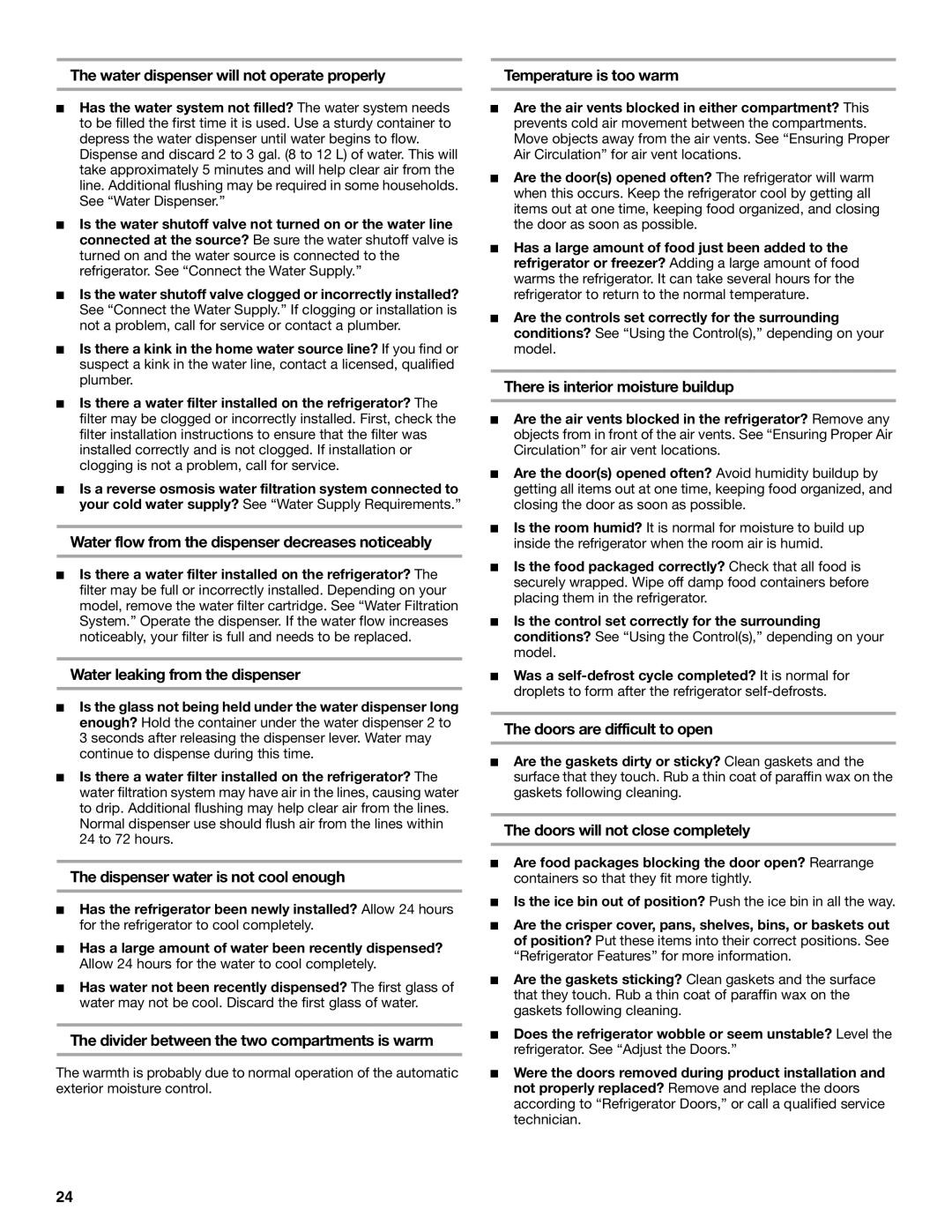■Has the water system not filled? The water system needs to be filled the first time it is used. Use a sturdy container to depress the water dispenser until water begins to flow.
Dispense and discard 2 to 3 gal. (8 to 12 L) of water. This will take approximately 5 minutes and will help clear air from the line. Additional flushing may be required in some households. See “Water Dispenser.”
■Is the water shutoff valve not turned on or the water line connected at the source? Be sure the water shutoff valve is turned on and the water source is connected to the refrigerator. See “Connect the Water Supply.”
■Is the water shutoff valve clogged or incorrectly installed? See “Connect the Water Supply.” If clogging or installation is not a problem, call for service or contact a plumber.
■Is there a kink in the home water source line? If you find or suspect a kink in the water line, contact a licensed, qualified plumber.
■Is there a water filter installed on the refrigerator? The filter may be clogged or incorrectly installed. First, check the filter installation instructions to ensure that the filter was installed correctly and is not clogged. If installation or clogging is not a problem, call for service.
■Is a reverse osmosis water filtration system connected to your cold water supply? See “Water Supply Requirements.”
Water flow from the dispenser decreases noticeably
■Is there a water filter installed on the refrigerator? The filter may be full or incorrectly installed. Depending on your model, remove the water filter cartridge. See “Water Filtration System.” Operate the dispenser. If the water flow increases noticeably, your filter is full and needs to be replaced.
Water leaking from the dispenser
■Is the glass not being held under the water dispenser long enough? Hold the container under the water dispenser 2 to 3 seconds after releasing the dispenser lever. Water may continue to dispense during this time.
■Is there a water filter installed on the refrigerator? The water filtration system may have air in the lines, causing water to drip. Additional flushing may help clear air from the lines. Normal dispenser use should flush air from the lines within 24 to 72 hours.
The dispenser water is not cool enough
■Has the refrigerator been newly installed? Allow 24 hours for the refrigerator to cool completely.
■Has a large amount of water been recently dispensed? Allow 24 hours for the water to cool completely.
■Has water not been recently dispensed? The first glass of water may not be cool. Discard the first glass of water.
The divider between the two compartments is warm
The warmth is probably due to normal operation of the automatic exterior moisture control.
■Are the air vents blocked in either compartment? This prevents cold air movement between the compartments. Move objects away from the air vents. See “Ensuring Proper Air Circulation” for air vent locations.
■Are the door(s) opened often? The refrigerator will warm when this occurs. Keep the refrigerator cool by getting all items out at one time, keeping food organized, and closing the door as soon as possible.
■Has a large amount of food just been added to the refrigerator or freezer? Adding a large amount of food warms the refrigerator. It can take several hours for the refrigerator to return to the normal temperature.
■Are the controls set correctly for the surrounding conditions? See “Using the Control(s),” depending on your model.
There is interior moisture buildup
■Are the air vents blocked in the refrigerator? Remove any objects from in front of the air vents. See “Ensuring Proper Air Circulation” for air vent locations.
■Are the door(s) opened often? Avoid humidity buildup by getting all items out at one time, keeping food organized, and closing the door as soon as possible.
■Is the room humid? It is normal for moisture to build up inside the refrigerator when the room air is humid.
■Is the food packaged correctly? Check that all food is securely wrapped. Wipe off damp food containers before placing them in the refrigerator.
■Is the control set correctly for the surrounding conditions? See “Using the Control(s),” depending on your model.
■Was a self-defrost cycle completed? It is normal for droplets to form after the refrigerator self-defrosts.
The doors are difficult to open
■Are the gaskets dirty or sticky? Clean gaskets and the surface that they touch. Rub a thin coat of paraffin wax on the gaskets following cleaning.
The doors will not close completely
■Are food packages blocking the door open? Rearrange containers so that they fit more tightly.
■Is the ice bin out of position? Push the ice bin in all the way.
■Are the crisper cover, pans, shelves, bins, or baskets out of position? Put these items into their correct positions. See “Refrigerator Features” for more information.
■Are the gaskets sticking? Clean gaskets and the surface that they touch. Rub a thin coat of paraffin wax on the gaskets following cleaning.
■Does the refrigerator wobble or seem unstable? Level the refrigerator. See “Adjust the Doors.”
■Were the doors removed during product installation and not properly replaced? Remove and replace the doors according to “Refrigerator Doors,” or call a qualified service technician.

